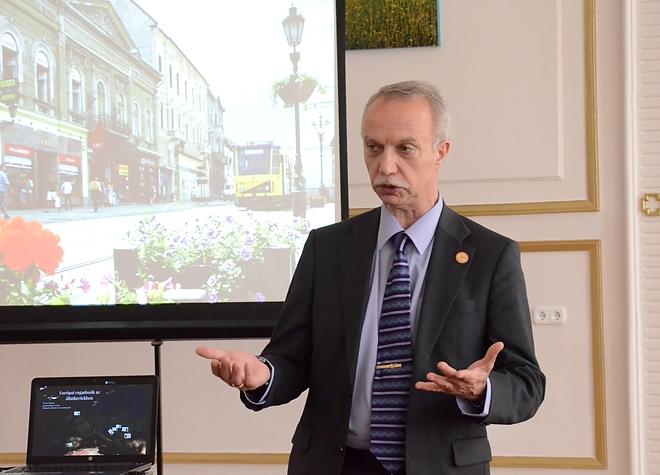Citizen Engagement: Mr. Péter Pfliegler deputy mayor of Miskolc, Hungary speaks to REMOURBAN
Author of the page
youris.com EEIG
450
Last modified by the author on 28/06/2018 - 11:13

Interview to Mr. Péter Pfliegler, deputy mayor of Miskolc, Hungary
What benefits for urban governance do you see coming as a result of citizen engagement?
Citizen engagement actions strengthen dialogue between inhabitants and city governance and help integrate the viewpoints of various stakeholders on a balanced way. A city leader must certainly not work for themselves alone and not for keeping their position but to defend and maintain positive results of the city and to further improve them. However, development of a city’s streets, buildings, squares and institutions should be basically aimed at improving the quality of life and living conditions for citizens. So city leaders are serving, in the most honorable term of the word, citizens.
This service cannot be carried out well without spending time and effort to meet with local people, listening to their needs, problems, preferences and remarks, as well as asking for their opinion and ideas on various planned developments. Never forgetting that, in fact, citizens are the final beneficiaries of urban improvements.
When city leaders carry out such activities on information and involvement in a fair manner, a sort of citizen involvement is achieved. Involvement is successful when citizens are enabled and motivated to share their views and ideas to city representatives who took these remarks into account for decision. Nevertheless, contrary decisions should be well explained for citizens and assure transparency and fairness of decision-making. Such city leadership may, still just “may”, get a new mandate when election-times come. The latter is certainly not the reason for governing the city in a reliable and transparent way with particular attention on exploiting synergies, but derives from the principles summarized above.
Additionally, one more advantage of citizen involvement from the perspective of the mayor’s office: no one is flawless and unerring and no one knows everything, even working with a great team. Considering and implementing complementary or new useful ideas coming from citizens can be more beneficial for the city than predicted in the original scenario.
In this regard, several positive examples have already been encountered in Miskolc and we see these projects are more and more accepted and supported by the residents. Engaging communities to the process of planning, developing, implementing a project can foster personal responsibility of people in general, but in also in particular can improve felt responsibility for the “jointly created” values, personal commitment to and ability to influence public affairs.
How can local governments and cities shape urban regeneration with the help of residents?
One of the common (and natural) features of urban developments is that they are for improving life conditions of citizens - for citizens and with them. In a contrary case, certain developments carried out that are finally not used by the citizens or may likely become neglected and opposed.
Urban regeneration is not a self-contained process but goes on for improving the city’s livability and attractiveness. Projects often go together with common inconveniences for people i.e. difficulties in traffic around the area being developed, noise and dust resulting from the works. These unpleasant outcomes are best to be discussed with locals, through municipal open citizen forums, to work on a common agreement on the acceptance of these side effects prior to their appearance, with regards to particular citizen benefits in post- implementation phase.
Municipal resident forums offer great opportunities for city leaders to discuss frankly the short and long term effects of the project in matter with residents turning on a sort of engagement level. Concerned citizens will be in need of regular information on the progress i.e. through media and similar follow-up occasions during project implementation. If problems and difficulties occur, engaged ones may frequently proposed feasible and affordable and well- fitting solutions. For example, new routes in the case a road development project implementation creates new bottleneck is urban traffic. City representatives are in charge to consider citizens’ suggestions and implement the most suitable ones in order to maintain livability of the area as much as possible during the transition phase, especially, for example, while construction works are carried out.
How do you measure the success of a citizen engagement initiative – and how can city leaders include a greater diversity and number of opinions?
Measuring success of citizen engagement has, to me, various aspects. To begin with, citizens sometimes initiate and literally knock on the city office door with useful and feasible ideas for particular reasonable improvements without asking them to get engaged. However, engagement definitely happens when more purposeful and solicited here. When a road, institution, traffic lights or crosswalk is developed in accordance to the residents’ proposals and preferences, maybe there is not so much need for measuring.
The other way around, the city launches open discussions on the planned future developments inviting citizens to share their views and ideas on, or suggest amendment of the proposed actions. Applying this approach in Miskolc, we have already seen several good examples for community involvement such as the joint planning of the city’s main square or the public decision on our new trams’ design. Such indicators as the number of proposals submitted to a “call for ideas” or certain online voting results are deemed notable inputs for measurement.
Share :



